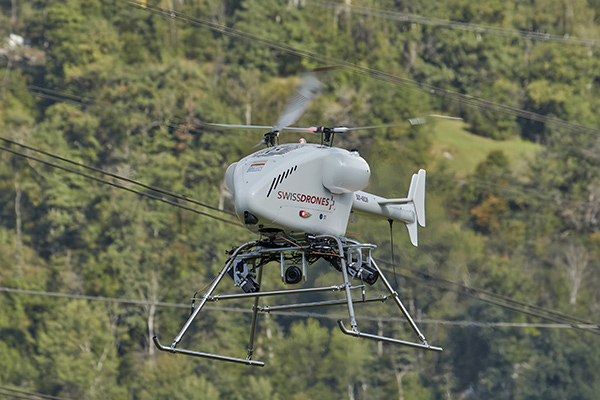Energy company leaders are bracing for a major, preventable disaster within the next decade without adoption of automated solutions.

By Ulrich Amberg, CEO of SwissDrones
This past Easter holiday turned into a weekend of darkness for the entire island of Puerto Rico when a transmission system failure caused a blackout, cutting electricity for 1.4 million customers and leaving 400,000 without water. What was meant to be a time of celebration for many became a rude awakening to the fragility of the energy grid.
And Puerto Rico isn’t the only case this year – many states across the nation are highly vulnerable to power outages and the Department of Energy (DOE) warns that blackouts in the U.S. could increase by 100 times in 2030.
These incidents are a result of our aging infrastructure, and energy leaders believe without urgent action to adopt alternative solutions, our systems will continue to fail at worsening scale. According to a study from SwissDrones (conducted by Censuswide), 89% of energy executives in North America believe deteriorating infrastructure will lead to a major, preventable pipeline or powerline incident within the next decade.
And disaster will hit in other ways – energy leaders agree that the U.S. will see a dramatic increase in infrastructure-related service interruptions in just the next five years. And over the next ten years, decaying infrastructure will cause a surge in consumer prices. These issues are preventable, but it requires effort from the energy sector to avert them.
87% of energy executives agree that the energy industry is more reactive than proactive when it comes to preparing for disasters. The problem with this approach is that the energy system is already under severe strain. The consequences abound – increased outages will continue to lead to blackouts and gas shortages. And the way today’s critical infrastructure is set up, particularly interconnected powerlines, one small breakdown can trigger broader system disruptions spanning many miles and communities.
There are also cost implications. Dealing with the fallout of a catastrophe is far more expensive than making early investments in protecting critical infrastructure. Data finds global outages are becoming more expensive, 54% saying recent outages exceed $100,000 in total costs and 20% citing the cost is more than $1m, a four percent year-on-year (YoY) increase.
In short, a reactive approach is just prolonging the inevitable – a lack of proactive leadership in energy infrastructure exposes society to higher risks and greater costs, damaging both public trust and corporate reputations.
When we add environmental factors into the mix, the energy infrastructure crisis worsens.
Hundreds of thousands of Los Angeles residents were left without power after the January 2025 wildfires – many of them several miles away from the active burning areas. And in 2021, Texas faced widespread blackouts that cost the state $90 billion.
Given this, it’s unsurprising SwissDrones’ data found that 96% of energy executives are not confident in their infrastructure holding up when there’s a large storm.
With every season bringing the threat of a severe weather crisis, preparedness is crucial for the utility companies who bear the responsibility and are expected to maintain electricity and water for their customers during these events.
Traditional inspections are typically done by manned helicopters, but these methods can no longer keep up with the demand and growing risks the energy sector faces.
There is a more crucial need for more efficient and scalable solutions to become more proactive against extreme weather. 62% of energy leaders surveyed in SwissDrones’ report support the adoption of automated infrastructure inspections & AI-powered data analysis, and 53% believe the industry needs to install more stringent regulations for infrastructure management.
They are also confident the solution will be adopted widely – almost all (96%) energy executives believe that unmanned aerial vehicles (UAVs) will largely replace manned helicopters for infrastructure inspections within the next decade.
Leaders see UAVs as a viable alternative solution for various reasons. For one, they agree that UAVs have additional use cases in the energy sector besides inspections, such as moving critical payloads like tools, replacement parts, and emergency supplies to hard-to-reach areas.
Not only do 96% of executives agree that UAVs are a safer and more efficient option than helicopter-based inspections, they also believe they are more environmentally-friendly. With reducing emissions being a top priority for the energy sector, executives see UAV adoption as a step closer to decarbonization – 97% say reducing their inspection-related emissions would have a significant impact on their organization’s overall carbon footprint.
88% of energy executives admit that regulatory hurdles are the top obstacle slowing UAV adoption in the energy sector today.
But it’s looking brighter on the other side. This year, the Federal Aviation Administration (FAA) introduced its Part 108 Notice of Proposed Rulemaking (NPRM), a framework of guidelines for Beyond Visual Line of Sight (BVLOS) operations for long-range commercial drones. While there is still discussion up in the air, the approval of these rules will pave the way for scaled adoption of UAVs across the nation.
The U.S. recognizes there’s a sense of urgency to fix our failing energy systems by equipping the industry with the tools to do so. Less than half (44%) of companies have already adopted UAVs for inspections, but this number will only increase once regulations are no longer a barrier.
As the U.S. progresses toward regulatory acceptance, the energy sector must be ready to adopt these technologies. Our systems have waited long enough – infrastructure needs urgent attention today to avoid the failures of tomorrow.

About the Author:
Ulrich Amberg is the CEO of SwissDrones, a leading provider of advanced aerial intelligence solutions and long-range uncrewed helicopter systems. Amberg drives the company’s global expansion to establish revolutionary aerial intelligence solutions and offer comprehensive end-to-end support for the energy and utilities industries. Ulrich has more than 25 years of experience in technology-enabled business transformation, professional services, and leadership roles across industries. He was a KPMG partner for eight years, where he held various management positions and led a consulting practice with 150 professionals. He holds degrees in electronics engineering and computer science and has completed a Corporate Leadership Development Program at INSEAD and the Advanced Management Program (AMP) at Harvard Business School.
Read more from the author:
An FAA rule will revolutionize energy infrastructure inspections. It just got a big boost. | Utility Dive, August 5, 2025
The Promise of AI: Improving America’s Aging Energy Infrastructure | The AI Journal, September 5, 2025
In this episode, I sat down with Beejan Giga, Director | Partner and Caleb Emerson, Senior Results Manager at Carpedia International. We discussed the insights behind their recent Industry Today article, “Thinking Three Moves Ahead” and together we explored how manufacturers can plan more strategically, align with their suppliers, and build the operational discipline needed to support intentional, sustainable growth. It was a conversation packed with practical perspectives on navigating a fast-changing industry landscape.